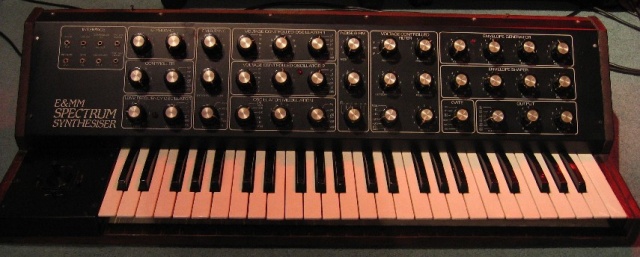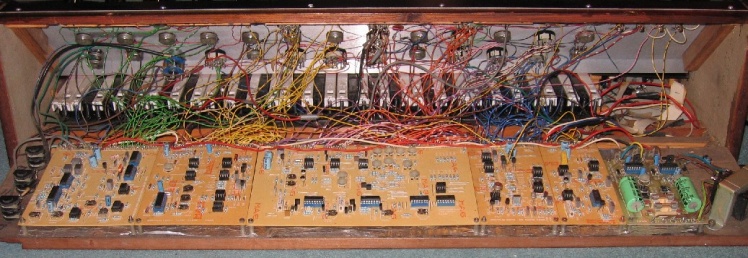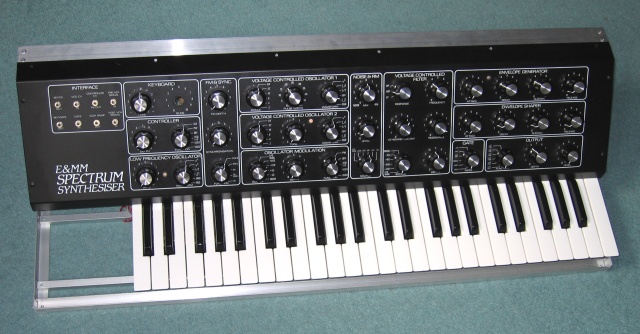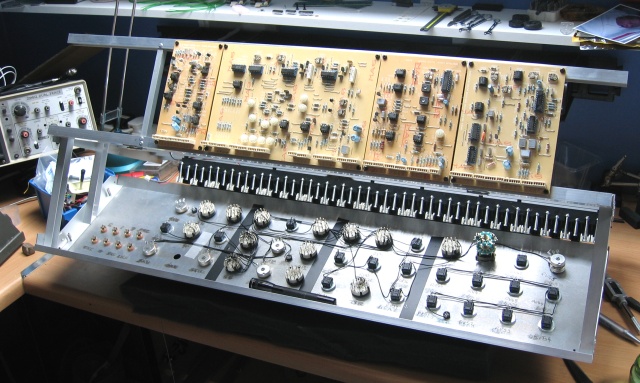E&MM Spectrum Synthesizer
I found this Spectrum synthesizer on eBay...

I wasn't expecting much, since it was described as 'partially working', and I've heard how badly most of these things were put together.
All components were present, with plenty of scratchy pots, bad rotary switches and crusty keyboard contacts. And look at the home-made spaghetti...

I decided the best approach was to completely strip it down and rebuild from scratch.
The original design for the case has a wooden sub-structure fitted with metal panels, but I decided I would go for an all metal case. I assembled a lightweight frame from aluminium angle, riveted together...

This frame will take bottom and rear panels in black painted aluminium sheet, and a nice set of wooden end-cheeks.
At the rear, a separate frame holds all the printed circuit boards. I've designed this to make it as easy as possible to access the panel to board wiring (which there is *loads* of).
With the synth placed upside down, the PCB frame folds round through 180 degrees, so I can get at all the front panel pots and PCB connector blocks with ease.

I'm also able to do any necessary component replacements without removing the boards from the frame, since all the component pins are accessible from behind...

All wiring is now complete...

...and with a couple of little fixes, the sound generating circuitry is fully functional !
I did find one design error - an incorrect resistor value in the ring modulator turns it into a much less effective amplitude modulator. R221 should be 100k, not 300k.
Sonically the Spectrum is how you would expect for a two-oscillator mono-synth based on Curtis CEMs.
The oscillator sync and FM section is more advanced than anything else I've seen, though for some reason they decided not to provide any way to balance oscillator levels, and there is only a single modulation assignment for the filter - so no EG and LFO modulation at the same time. At least until I add dedicated controls, anwyay.
Here's an example mp3 of the sort of thing you can do with variable sync.
It starts with VCO 2 being modulated by the LFO; then VCO1 is added; then sync is turned on at 100%; finally sync is set to 50%
The sync level control allows you to set a threshold at which VCO2 is reset based on how far through its cycle it is, which makes for some interesting waveforms.
I replaced the original CV keyboard with a Fatar 4 octave velocity sensing MIDI mechanism.
An onboard MIDI/CV processor provides local control of the synth from the keyboard, plus external MIDI interfacing.
I subsequently replaced the CEM filter with an SSM2044 on a daughterboard. It sounds better, IMO.
I also have level controls fitted for each VCO output, and a knob to control velocity mod of filter cutoff.
And one little gimmick... a small PIC driving an RGB LED in the LFO section. As the LFO rises and falls, the LED sweeps through the rainbow.

Last update: 10th February 2013
home







